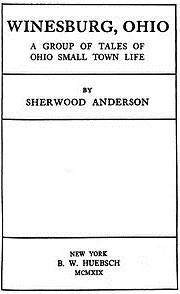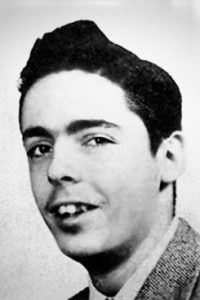Winesburg, Ohio
Sherwood Anderson
Review By Dan Geddes
Winesburg’s Reception
I can understand why Winesburg, Ohio was shocking for its time: the veneer of Victorian innocence in small town American life is pierced, revealing tormented psyches even among seemingly ordinary people. Nearly all of the older characters nurture old wounds, and the young, fresh ones. Naturally, their thoughts often tend toward sex, or at least romance, but in a way that appears quaint today.
Like many books with a tincture of scandal, Winesburg‘s risqué reputation no doubt aided its critical reception. In 1919, the year of Winesburg‘s publication, even Theodore Dreiser was considered shocking. So the sex, or at least the depiction of characters thinking about it in Winesburg, helped create the impression of a “cutting edge” book, a book that dared to break taboos.
Besides the mixed, but sometimes extravagant critical reception, commercial success eluded Winesburg, Ohio. But it gave Sherwood Anderson access to the some of the rising writers of the 1920s, including both Hemingway and Faulkner. Indeed, Anderson’s primary importance may be the indirect influence he exerted on writers of the 1920s and 1930s.
Story Collection or Novel
Winesburg, Ohio consists of a series of tales, united by a common place and by the character of George Willard, Anderson’s personal representative in the novel. I will treat Winesburg as a novel, primarily because of its common locale, and George Willard, despite the fact that the book features neither the sustained plot nor action characteristic of novels. Nearly all of the tales can stand alone as short stories (some were published individually before Winesburg), and receive no direct reinforcement from the other tales.
As George Willard’s bildungsroman,Winesburg, Ohio is pretty lean. George serves as a young father confessor to the town–an odd role for a newspaperman, in whom wiser souls would avoid placing their confidence. Although in “Nobody Knows,” “The Teacher,” and other tales George’s first sexual and artistic yearnings are treated, George’s development is not the centerpiece of the novel. George Willard, as literary character, is stretched too thin because of his role as a unifying device for other disparate narratives.
I treat Winesburg, Ohio as a novel primarily because I feel Anderson wished it be treated that way. Just as organic stories revolve around theme, Winesburg, Ohio reads as an organic novel, circling around the same small town, the recurring themes of frustration and regret, presenting characters to fill Anderson’s Book of the Grotesque.
Anderson’s Style
Much critical attention has been paid to Anderson’s style, primarily because of its influence on Hemingway, the most influential stylist in 20th century literature. Anderson’s style features short declarative sentences, often conjoined with ‘and’s. ‘And’ has been considered the most value-free of connectives, because the writer makes no claims of causal connections, or other qualifiers. ‘And’ also serves as a rhythmic device, allowing for variety in sentence length–much needed in a style with simple diction.
Anderson’s diction also helped his reception among some critics, who found the “literary artifice” of writers like James to be unrealistic in a literary age increasingly characterized by Realism. Unlike naturalistic writers who often went to great lengths to describe settings and characters’ appearances, Anderson’s characterizations of people and places stress the “feel” of the matter, rather than appearance. Anderson is at his most effective when he simply describes a character’s frustrated longings. He is neither a master psychologist nor a strong dramatist.
Anderson’s Subject
Rather than George Willard, who, though appearing in some function (usually a listener) in most of the stories, is hardly a main character in a traditional novelistic sense, the real subject of Winesburg, Ohio is the Grotesque, the frustrated hopes and ambitions that weigh down the lives of most people. Much of the book’s poignancy springs from its depiction of characters’ “tragic flaws” (in the loose sense).
“Hands,” often considered one of the best of the Winesburg stories, concerns Wing Biddlebaum, a former school teacher, who was forced to flee a Pennsylvania town after it was falsely alleged that he had been molesting one of his students. The story illuminates one of Anderson’s best narrative strategies: presenting a character in present time, relating the character’s mysteriousness to the rest of the town, and then, at long last, the skeleton in the closet is revealed to George Willard. Although many critics treat Wing as simply a homosexual, in Anderson’s depiction he is seen as more of a genuinely kind man, someone “born” to teach small boys, because of his natural kindness, and gentle ability to lead.
Despite this natural kindness, Wing is punished, sentenced to spend the rest of his life picking strawberries, an unknown man in a small town.
Three of Anderson’s stories (“Adventure,” “The Teacher,” “Death”) deal with sexually unsatisfied women, women who missed out on real romantic love, or on love at all. Perhaps some of the negative critical reception of Winesburg was due to its honest treatment of women’s’ sexual longings. “Adventure” concerns a 27 year old clerk who many years before had a boyfriend. He left with plans to find a job in the city, and then send for her, but he never did. Nevertheless, even many years later, she still clings to the hope that he will send for her. Wanting, as Anderson describes it in at least two of these three stories, simply some kind of recognition from a man–not necessarily sex–Alice Hindman strips naked and walks outside her home. An old man walks by, and she is somewhat embarrassed and goes back inside, but the reader is left with the impression that this was a moment of liberation for her, perhaps the last bloom of her youth before the inevitable acceptance of spinsterhood.
“The Teacher” depicts Kate Swift, who apparently has given up hopes of marriage and family for her devotion to teaching literature. She has a somewhat romantic attraction for Young George Willard, a former student of hers who she feels has some potential as a writer. (This story is a good place to learn some of Anderson’s own theories of what it is to be a writer.) Kate Swift and George Willard fall into each other’s arms in the latter’s office, but at the last moment, she beats him with her fists, repelled by what she thought she had wanted.
“Death” describes the death of George Willard’s mother, who some years before, at the age of 41, told her troubles to Dr. Reefy. Reefy becomes more than a sympathetic ear, and falls in love with the once lovely woman. Just as they are on the verge of indulging their lust, they are inadvertently interrupted, and, shamed, never return to the brink of love. Again, the moment achieves poignancy because it is the last time in her life that she may achieve a passionate union.
The scope of many of the tales spans the bulk of a character’s life, so that we are given a sense of what the sum total of that life has meant. The four-part story “Godliness,” (which in many ways is only loosely connected to the rest of the tales) deals with a man’s (Jesse Bentley) attempt to become the father of a new David. A modern man of Godliness. His efforts to extend his land holdings are, like Abraham’s, very successful, but siring a David eludes him; he only seers daughters. Instead his hopes are foisted on a grandson, aptly named David, who as a boy never understands the import or meaning of his grandfather’s utterances. But Jesse’s monomania ultimately destroys his relationship with his own daughter, whom he should have loved despite his longings to start a dynasty of godliness.
We are also presented the summation of men’s lives in, for example, “Respectability” in which we are described Wash Williams’ story. Wash, ironically named because he is the dirtiest man in town, was once married to a beautiful woman who became unfaithful. Wash gives her all his money, and goes on to denounce all women and marriages vehemently, a stance that gives him some respectability among the townsmen. (“Perhaps he is right”, they may have been thinking.) Just as the incident of his wife’s infidelity is the pivotal moment of Wash Williams’ life, so in “The Untold Lie” are we presented a critical fork in the road. Hal Winters confides to Ray Pearson that he has gotten a woman in trouble. He asks Ray, the older man, whether he should do the right thing, or run for the hills to preserve his freedom. Ray does not answer. He goes home and begins thinking about the course of his own life, how hard he has worked for his family. He arrives at a sort of epiphany whereby he runs to tell Hal not to marry to preserve his freedom. Upon finding the younger man, Hal tells Ray that he will ask the woman to marry him. Ray quickly realizes the priceless value of his own wife and children, and rejects his earlier epiphany.
While I have maintained that the true subject of Winesburg, Ohio is the Grotesque (here simply meaning the effects of the frustration of human ambition) the result of such depictions is not always somber. Even though some of the tales leave us saddened by the quickness and transience of human life, other tales (such as “The Untold Lie”) convey the beauty in life, however transient it may be.
Anderson’s Place In American Literature
Most critics agree that Winesburg, Ohio remains Sherwood Anderson’s primary literary legacy, though it is somewhat supplemented by some other fine stories. Winesburg, Ohio does stand on its own as a “minor classic” in that it has endured, is still read at least by students and literati. Its charm and quaintness endure as well the passion of some of the stories. More importantly, Anderson is seen as the direct literary ancestor of Hemingway, as well as of a new generation of simple, direct, powerful writers. He also served as a mentor to Faulkner, who, despite the difficulty in detecting any similarity in their styles, benefited by Anderson lending his name to get Faulkner’s first novel published. Anderson inspired Faulkner as to what the life of a successful writer could be. In these forms of influence, Anderson served a function similar to Ezra Pound and Gertrude Stein, two other notorious nurturers of talent, whose own talent are still somewhat debatable. And Winesburg, Ohio although perhaps eclipsed by a piece like Our Town remains an enduring depiction of small town American life.









Be First to Comment